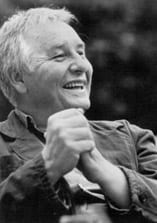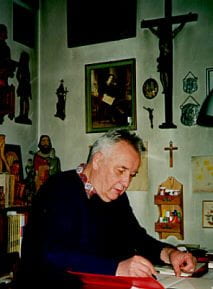6 December 1933, Czernica near Rybnik – 12 November 2010, Katowice
“I was born in Silesia. . . Old, ancient Polish land. But three cultures have always coexisted there: Polish, Czech, German… Why do I like Czech music? Where does my knowledge and liking of German and Austrian music come from? Why do I worship Mozart, Schumann, Schubert, Brahms, Beethoven, Bach? […] Why am I enamored with Szymanowski and Chopin? Why did I grow up with them? Because at the beginning of my musical education, when I had no idea about music … these names were always near me: Beethoven, Chopin, Szymanowski. . . Does one need to consider it in a special way, does one need to think much about this? I do not think so. . . Nobody chooses their time and place of birth.“
[Henryk Mikołaj Górecki, Zakopane, 18 July 1997]
Biography
Henryk Mikołaj Górecki studied composition with Boleslaw Szabelski at the State Higher School of Music (PWSM) in Katowice (1955-1960). After a post-graduate sojourn in Paris, he became a professor of composition at the PWSM in Katowice and, during the years 1975-1979, its Rector. The phenomenal success of his Symphony no. 3 (Gramophone’s bestselling CD in 1993) has astounded many of his contemporaries, especially in Poland, where the work had been known for more than a decade.
Górecki has worked with great determination to develop his own compositional voice by assimilating the techniques of his predecessors (Bartók, Szymanowski) and those active around him (Boulez, Xenakis, Nono), as well as by paring away all elements extraneous to his personal expression. These processes were carried out through the 1950s and 1960s, beginning with the Four Preludes for piano from 1955, his first numbered opus, and reaching full maturity with Old Polish Music from 1969. This is the most radical and dissonant period in his output: in the 1960s, Górecki belonged to the small group of the most avant-garde composers of his time. Together with Penderecki, Serocki, and others he established a pattern for new music: the more dissonance and the harsher the sound, the better. This style of writing, associated with the Polish school of the 1960s is alternatively known as “sound mass composition” or “sonoristic composition.”

In order to reduce music to pure sound, all elements, except tone color, were stripped away in such of Górecki’s works as, for example Genesis (1962-1963) or the aggressive Scontri for large symphony orchestra (1960), a composition filled with clashes of vertical and horizontal sound patterns, often organized serially.
Beginning with Ad Matrem (1971) and continuing through to Symphony No. 3 (1976) and Beatus Vir (1979), Górecki worked to achieve a direct link between the emotional and spiritual content of texts, both sacred and traditional, and his musical architecture. He sought inspiration in early Polish music: a 13th-century conductus and a 16th-century polyphonic song. The focus on vocal music throughout this period led quite naturally to an emphasis on melody, with a resulting simplification of the harmonic and textural elements. This gradual progress away from dissonance towards consonance, away from aggressive, dramatic, intense music, towards a more mellow style can already be seen in Symphony No. 2, Copernican (1972).
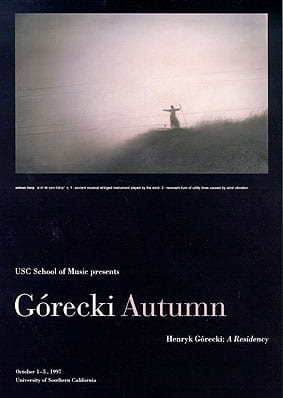
The 1980s saw an expansion of Górecki’s compositional resources to encompass radical contrasts in tempo, dynamics, density and harmonic dissonance. These elements cooperated to create a unified, highly concentrated musical expression, manifested in a remarkable series of chamber works, from the trio Lerchenmusik (1984) to Little Requiem for a Polka for an ensemble of fourteen instruments (1993). These compositions resound with echoes of Chopin, Beethoven, and Szymanowski. They also draw inspiration from colors and rhythms of folk music: the strong accents, harsh timbres, and relentless ostinati of mountain dances from the Tatra Mountains and Podhale region, the melancholy clarinet tunes of Silesia, and the impetuousness of the Czech or Silesian polkas.
For many, Górecki’s Symphony No. 3 represent his highest achievement. Still, he has continued to carry forward the musical, emotional and spiritual concerns with that always fascinated him. As he had once said, “music is one of the domains that people really need, and its importance only depends on whether one knows how to receive it.”
In His Own Words
“Composing is a terribly personal matter: the overcoming of difficulties, gaining knowledge, deciding upon a certain order, a certain method of constructing a new piece. This is important. You have to chose your way, you have to pick a proper path from an infinite number of possibilities. What do I do? In the past I invented and worked out detailed frameworks for my pieces. I had everything prepared and described before the work was composed. This started from the First Symphony; also in Scontri, Monologhi, Elementi I introduced different ways of structuring the pieces. Later I just knew – I had a technique and then other ideas came in … Let me put it this way: you scholars would want to know too much. Of course it is important to know how a piece is constructed and how it was made. But later this mechanism, this architecture ceases to be all important; the composer thinks about the forms that the music should be “poured into.” […] Music begins with sound. It is always based on some musical association, a musical theme or a structure. Now it is fashionable to say that there are no themes, but they continue to exist. At times I even treated a 12-tone series as a theme. When composing I always begin with introducing some order. I have many things prepared much, much earlier than I begin to compose a piece. In this way I have researched and analyzed the possibilities provided by my materials. However, many pieces that I had worked on have never been finished. I only ordered the materials.“
[Górecki’s interview with Maja Trochimczyk, 1998]
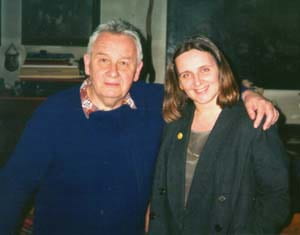
“I think that music is one of the domains that people really need, and its importance only depends on whether one knows how to receive it. Every person needs to be prepared to know how to “use” music. Not only music; also literature, painting, sculpture, and film [. . .] Tarkowski said that art is prayer. It is something that I also emphasize. But it is difficult to understand: one has to mature to this thought. It seems to many people that prayer means to “recite the Hail Mary” but someone may recite “Hail Mary” as many times as one wants and it will not be prayer. Olivier Messiaen said during a meeting in Katowice that he is a man of prayer. But what does he do? He writes his notes down, he listens to his birds. And this is supposed to be prayer?”
[Górecki’s interview with Maja Trochimczyk, 1997]
Selected Compositions
For List of Works, click here.
For Bibliography, click here.
For Discography, click here.
Vocal – Instrumental Music
Three Songs for medium voice and piano Op. 3 (1956); ca 4′; text by Juliusz Słowacki and Julian Tuwim: Do Matki [To Mother]; Oda do wolności [Ode to Liberty]; Ptak [A Bird]
Epitafium for mixed choir and instrumental ensemble Op. 12 (1958); text by Julian Tuwim; 5′ (B&H)
Monologhi per soprano e tre gruppi di strumenti Op. 16 (1960); text by composer; ca 17′ (B&H)
Genesis III: Monodramma per soprano, metalli di percussion e sei violbassi Op. 19 No. 3 (1963); 10′ (B&H)
Ad Matrem for soprano solo, mixed choir and orchestra Op. 29 (1971); text by composer; 11′ (B&H)
Dwie pieśni sakralne [Two Sacred Songs] for baritone solo and orchestra Op. 30 (1971); text by Marek Skwarnicki; 5′
Dwie pieśni sakralne [Two Sacred Songs] for baritone and piano Op. 30bis (1971); text by Marek Skwarnicki; 5′
II Symfonia “Kopernikowska” [Symphony No. 2 “Copernican”] for soprano, baritone, mixed choir and large orchestra Op. 31 (1972); texts in Latin include Psalms no. 145, 6, 135 (verse 7-9), and an excerpt from Book I of “De revolutionibus orbium caelestium” by Nicolaus Copernicus, ca 37′
III Symfonia “Symfonia pieśni załosnych” [Symphony No. 3 “Symphony of Sorrowful Songs”] for soprano solo and large orchestra Op. 36 (1976); texts include: 15th c. lamentation of the Holy Cross Monastery (I movement); a young prisoner’s inscription on the wall of her cell in Zakopane’s Gestapo prison (II movement); folk song from the Opole region; 54-55′
Beatus Vir psalm for baritone solo, mixed choir and large orchestra Op. 38 (1979); Latin texts include Psalms no. 142, 30, 37, 66, 33; 33-35′
O Domina Nostra Medytacje o Jasnogorskiej Pani Naszej [Meditations on Our Lady of Jasna Góra] for soprano and organ (1985); ca 35′
Dobranoc [Good night] for soprano, alto flute, piano and 3 tam-tams Op. 63 (1990); ca. 30′
Trzy fragmenty do słów Stanisława Wyspiańskiego [Three Fragments to texts by Wyspiański] song cycle for voice and piano (1996)Lobgesang Op. 76 for mixed choir and glockenspiel (2000)
Kyrie for choir and chamber orchestra (2005)
Orchestral Music
Pieśni o radości i rytmie [Songs of Joy and Rhythm] for 2 pianos and chamber orchestra, Op. 7 (1956, rev. 1959); ca. 14′ (PWM)
Symphony No. 1 “1959” for string orchestra and percussion, op. 14 (1959); ca. 20′ (PWM)
Scontri for orchestra, Op. 17 (1960); 17’30” (PWM)
Trzy utwory w dawnym stylu [Three Pieces in an Old Style] for string orchestra (1963); ca. 10′ (PWM)
Choros I per strumenti ad arco Op. 20 (1964); 18′ (PWM)
Refren [Refrain] for orchestra Op. 21 (1965); ca. 16-17′ (PWM)
Muzyka staropolska [Old Polish Music] for orchestra Op. 24 (1969); ca. 23′ (PWM)
Canticuum graduum for orchestra Op. 27 (1969); ca. 12′ (PWM)
Trzy tańce [Three Dances] for orchestra Op. 34 (1973); 12′ (PWM)
Concerto for harpsichord (or piano) and string orchestra Op. 40 (1980)
Concerto-Cantata for flute and orchestra Op. 65 (1992); 22′ (B&H)
Chamber Music
Variazioni per violino e pianoforte Op. 4 (1956); ca 10′
Quartettino for 2 flutes, oboe and violin Op. 5 (1956); ca 8′
Sonatina w jednej części [Sonatina in One Movement] for violin and piano Op. 8 (1956); ca 2’30”
Sonata na dwoje skrzypiec [Sonata per due violini] Op. 10 (1957); ca. 6’30”
Concerto for five instruments and string quartet Op. 11 (1957); ca. 10’30”
Pięć utworów [Five Pieces] for two pianos Op. 13 (1959); 7’30”
Genesis I: Elementi per tre archi Op. 19 No. 1 (1962) 12’42”
Genesis II: Canti strumentali per 15 esecutori Op. 19 No. 2 (1962); 8’04”
Muzyczka II [La Musiquette II] for 4 trumpets, 4 trombones, 2 pianos and percussion (5 performers) Op. 23 (1967); ca. 7’30”
Muzyczka III [La Musiquette III]or violas Op. 25 (1967); may be played by any multiple of the minimum no. of 3 violas; ca. 14′
Muzyczka IV “Koncert puzonowy” [La Musiquette IV “Trombone Concerto”] for trombone, clarinet, cello and piano Op. 28 (1970) ca 9′
Trzy małe utworki [Three Little Pieces] for violin and piano Op. 37 (1977)
Recitatives and Ariosos “Lerchenmusik” for clarinet, cello, and piano Op. 53 (1984); ca 45′
Dla Ciebie, Anne-Lill [For You, Anne-Lill] for flute and piano Op. 58 (1986-90)
Aria opera scene for tuba, piano, tam-tam and bass drum Op. 59 (1987)
Już się zmierzcha [Already It Is Dusk] (String Quartet No. 1) Op. 62 (1988); 16′
Quasi una Fantasia II Kwartet Smyczkowy [String Quartet No. 2] Op. 64 (1992)
Kleines Requiem für eine Polka for piano and 13 instruments Op. 66 (1993); 25′ (B&H)
Kleine Phantasie for violin and piano (1997)
Dla Jasiunia [For Johnny] 3 pieces for violin and piano (2003)
Po co żeś tu przyszło siwa mgło? [Why Come Here, Hoary Fog?] short pieces for two group of violins (2003)
… pieśni śpiewają [… songs are sung] String Quartet No. 3 (1999-2005)
Choral Music
Euntes ibant et flebant for unaccompanied mixed choir Op. 32 (1972); Latin texts from Psalms no. 125, 6, 94; 9′
Dwie piosenki [Two Songs] for choir of 4 equal voices Op. 33 (1972); text by Julian Tuwim ca 4’30”
Amen for unaccompanied mixed choir Op. 34 (1975); ca 8′
Szeroka woda [Broad Waters] five folk songs for unaccompanied mixed choir Op. 39 (1979)
Miserere for large unaccompanied mixed choir Op. 44 (1981); 35′
Wisło moja, Wisło szara [My Vistula, Grey Vistula] folk song for unaccompanied mixed choir Op. 46 (1981)
Trzy Kołysanki [Three Cradle Songs] for unaccompanied mixed choir Op. 49 (1984)
20 Sacred Songs for Unaccompanied Mixed Choir (1986; pub. 2013)
Totus Tuus for unaccompanied mixed choir Op. 60 (1987)
Niech nam żyją i śpiewają [May They Long Live and Sing] for vocal group (2000)
Hej, z góry, z góry! koniku bury [Run Downhill, Dun Horse] five songs from Kurpie region for a cappella choir (2002)
Pieśń Rodzin Katyńskich [Song of Katyń Families] for mixed choir a cappella (2004)
Music for Solo Instruments
4 Preludes for piano Op. 1 (1955); 8′
Sonata No. 1 for piano Op. 6 (1956 -1990)
Cantata for organ Op. 26 (1968); ca 13′
Trzy diagramy [Three Diagrams] for flute solo Op. 1 (1959); ca 6′
Diagram No. 4 for flute solo Op. 18 (1961)
List of Opus Numbers
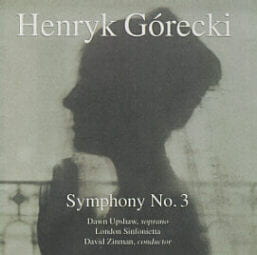
Op. 1 – Four Preludes (1955) piano solo
Op. 2 – Toccata (1955) two pianos Op. 3
Three Songs (1956) medium voice and piano
Op. 4 – Variations (1956) violin and piano
Op. 5 – Quartettino (1956) two flutes, oboe, violin
Op. 6 – Sonata No. 1 (1956/84/90) piano solo
Op. 7 – Songs of Joy and Rhythm (1956) two pianos and chamber orchestra
Op. 8 – Sonatina in One Movement (1956) violin and piano
Op. 9 – Five Little Preludes (1956) piano solo
Op. 10 – Sonata (1957) two violins
Op. 11 – Concerto (1957) five instruments and string quartet
Op. 12 – Epitafium (1958) mixed choir and instruments
Op. 13 – Five Pieces (1959) two pianos
Op. 14 – Symphony No. 1, “1959” (1959) orchestra
Op. 15 – Three Diagrams (1959) solo flute
Op. 16 – Monologhi (1960) soprano, 2 harps, percussion
Op. 17 – Scontri (1960) orchestra
Op. 18 – Diagram IV
Op. 19 – Genesis
Trzy Utwory w Dawnym Stylu (1963)
Op. 20 – Choros I (1964) string orchestra
Op. 21 – Refren (1965) orchestra
Op. 22 – Muzyczka I (1967) two trumpets and guitar
Op. 23 – Muzyczka II (1967) 4 tpts, 4 tbns, 2 pfs, percussion
Op. 24 – Muzyka Staropolska (1969) orchestra
Op. 25 – Muzyczka III (1967) violas
Op. 26 – Cantata (1968) organ
Op. 27 – Cantinticum Graduum (1969) orchestra
Op. 28 – Muzyczka IV (1970) clar, trom, vc, pf
Op. 29 – Ad Matrem (1971) sop, choir, orchestra
Op. 30 – Two Sacred Songs (1971) baritone, orchestra
Op. 31 – Symphony No. 2, “Copernican” (1972)
Op. 32 – Euntes Ibant et Flebant (1972) choir
Op. 33 – Two Little Songs of Tuwim (1972) choir
Op. 34 – Three Dances (1973) orchestra
Op. 35 – Amen, (1975) choir
Op. 36 – Symphony No. 3, “Symphony of Sorrowful Songs” (1976)
Op. 37 – Three Little Pieces (1977) violin, pf
Op. 38 – Beatus Vir (1979) baritone, choir, orchestra
Op. 39 – Szeroka Woda (1979) mixed choir
Op. 40 – Concerto for Harpsichord and String Orchestra (1980)
Op. 41 – Mazurkas (1980) piano (unavailable)
Op. 42 – Two Songs of Lorca (1956/80) med. voice, pf (unavailable)
Op. 43 – Blessed Raspberry Songs (1980) voice, pf (unavailable)
Op. 44 – Miserere (1981) choir
Op. 45 – Dark Evening is Falling (1981) folksongs for choir (unavailable)
Op. 46 – Wis o Moja, Wis o Szara (1981) mixed choir
Op. 47 – Lullabies and Dances (1982) violin, pf (unavailable)
Op. 48 – Two Songs of Slowacki (1983) voice, pf (unavailable)
Op. 49 – Three Lullabies (1984, rev. 1991) mixed choir
Op. 50 – O my little garland of lavender (1984) folksongs; choir (unavailable)
Op. 51 – Cloud comes, rain falls (1984) folksongs for choir (unavailable)
Op. 52 – Sundry Pieces (1956-90) piano (unavailable)
Op. 53 – Lerchenmusik (1984) clar, vc, pf
Op. 54 – Five Marian Songs (1985) choir
Op. 55 – O Domina Nostra (1985) soprano, organ
Op. 56 – Under Your Protection (1985) choir (unavailable)
Op. 57 – Angelus Domini (1985) choir (unavailable)
Op. 58 – For You, Anne-Lill (1986-90) flute, pf
Op. 59 – Aria (1987) tuba, pf, tam-tam, bass-drum
Op. 60 – Totus Tuus (1987) choir
Op. 61 – Come Holy Spirit (1988) choir (unavailable)
Op. 62 – Already It Is Dusk (String Quartet, No. 1) (1988)
Op. 63 – Good Night (1990) soprano, alto flute, pf, tam-tam
Intermezzo (1990) piano
Op. 64 – Quasi una Fantasia (String Quartet No. 2) (1990-91)
Op. 65 – Concerto-Cantata (1992) flute, orchestra
Op. 66 – Kleines Requiem für eine Polka (1993) ensemble
Op. 67 – … pieśni śpiewają […songs are sung] String Quartet No. 3 (1993
Op. 68 – Three Songs of Konopnicka (1954/95) voice and piano
Op. 69 – New song cycle (1996) voice and piano]
Op. 70 – Valentine Piece (1996) flute solo and little bell
Op. 71 – Piece for clarinet and string quartet (1996)
Op. 72 – Sanctus Adalbertus (1997)
Op. 73 – Kleine Phantasie for violin and piano (1997)
Op. 75 – Hej, z góry, z góry! koniku bury [Run Downhill, Dun Horse] five songs from Kurpie region for a cappella choir (2002)
Op. 76 – Lobgesang for mixed choir and glockenspiel
Op. 77 – Niech nam żyją i śpiewają [May They Long Live and Sing] for vocal group (2000)
Op. 78 – Quasi una fantasia for string orchestra (2002)
Op. 79 – Dla Jasiunia [For Johnny] 3 pieces for violin and piano (2003)
Op. 80 – Po co żeś tu przyszło siwa mgło? [Why Come Here, Hoary Fog?] short pieces for two group of violins (2003)
Op. 81 – Pieśń Rodzin Katyńskich [Song of Katyń Families] for mixed choir a cappella (2004)
Op. 83 – Kyrie for choir and chamber orchestra (2004 – 2005)
Op. 84 – Selected Sacred Songs for Unaccompanied Mixed Choir (1986, pub. 2013)
Op. 85 – IV Symphony. Tansman Episodes for piano, organ and symphony orchestra (2009) [completed by Mikołaj Górecki]
Honors and Awards
1960 – First Prize at the Young Composers’ Competition of the Polish Composers’ Union for Monologi I
1961 – First Prize at the Youth Biennale in Paris for Symphony no. 1 “1959”
1965 – Award of Third Degree from the Ministry of Culture and Fine Arts
1968 – First Prize at the Szczecin Composers’ Competition for Kantata for organ
1969 – Award of First Degree from the Ministry of Culture and Fine Arts
1970 – Annual Award from the Polish Composers’ Union
1973 – First Prize at the UNESCO International Composers Rostrum in Paris for Ad Matrem
1973 – Award of First Degree from the Ministry of Culture and Fine Arts
1976 – State Award of the First Degree
1992 – Award of the Ministry of Foreign Affairs
1994 – Honorary Doctorate from the University of Warsaw
Publishers
PWM Edition (PWM)
Polskie Wydawnictwo Muzyczne
Krasińskiego 11a
31-111 Kraków, Poland
Tel.: +48-12-22-0174
PWM Edition represents Górecki in Poland, Albania, Bulgaria, China, Yugoslavia, Cuba, North Korea, Vietnam, Romania, Czech Republic, Slovakia, Hungary and the CIS
The publisher distributing his music to rest of the world is Boosey & Hawkes, Ltd. (B&H):
Boosey & Hawkes Music Publishers Ltd.
295 Regent Street
London W1R 8JH
+44 (171) 580 2060
+44 (171) 580 5815
From North America (USA, Canada, Mexico) contact the New York office of Boosey & Hawkes
Copyright and Promotion Office:
35 East 21st Street
New York NY 10010-6212
212-358-5300
212-358-5301
bhpromo@ny.boosey.com
Sales and Marketing Information:
212-358-5339
212-358-5303
bhsales@ny.boosey.com
Rental Library:
212-358-5379
212-358-5307
Serious Music Promotion:
212-358-5306
Some recent works (e.g. O Domina Nostra) have been published by Chester Music
(Chester):
J. & W. Chester/Edition Wilhelm Hansen London Ltd.
Eagle Court, London EC1M 5QD
In North America Chester Music is represented by:
G. Schirmer Music Corp.
P.O. Box 572
4445 Bellvale Road,
Chester, NY 10918
914-469-2271
914-469-7544
Links
Page updated on 27 February 2018
